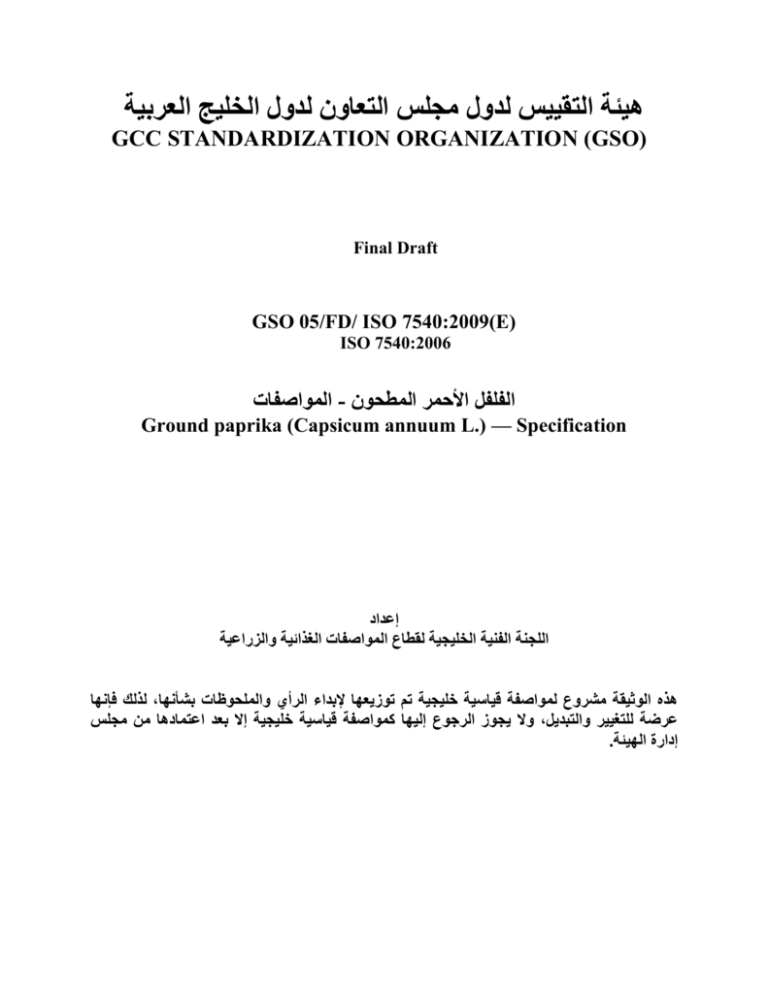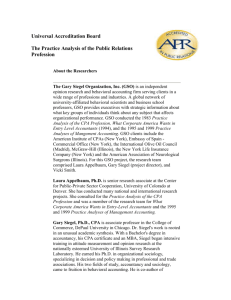هيئة التقييس لدول مجلس التعاون لدول الخليج العربية
advertisement

هيئة التقييس لدول مجلس التعاون لدول الخليج العربية )GCC STANDARDIZATION ORGANIZATION (GSO Final Draft )GSO 05/FD/ ISO 7540:2009(E ISO 7540:2006 الفلفل األحمر المطحون -المواصفات Ground paprika (Capsicum annuum L.) — Specification إعداد اللجنة الفنية الخليجية لقطاع المواصفات الغذائية والزراعية هذه الوثيقة مشروع لمواصفة قياسية خليجية تم توزيعها إلبداء الرأي والملحوظات بشأنها ،لذلك فإنها عرضة للتغيير والتبديل ،وال يجوز الرجوع إليها كمواصفة قياسية خليجية إال بعد اعتمادها من مجلس إدارة الهيئة. تقديم هيئة التقييس لدول مجلس التعاون لدول الخليج العربية هيئة إقليمية تضم في عضويتها األجهزة الوطنية ومن مهام الهيئة إعداد المواصفات القياسية الخليجية بواسطة،للمواصفات والمقاييس في دول الخليج العربية .لجان فنية متخصصة 5وقد قامت هيئة التقييس لدول مجلس التعاون لدول الخليج العربية ضمن برنامج عمل اللجنة الفنية رقم "اللجنة الفنية الخليجية لقطاع المواصفات الغذائية والزراعية" بتحديث المواصفة القياسية الخليجية رقم وقامت دولة اإلمارات العربية المتحدة." المواصفات- " الفلفل األحمر المطحونGSO 1344:2002 .بإعداد مشروع هذه المواصفة الئحة فنية) خليجية دون إدخال أية تعديالت فنية عليها/ وقد اعتمدت هذه المواصفة كـ (مواصفة قياسية .م / / الموافق، هـ/ / الذي عقد بتاريخ،) ( وذلك في اجتماع مجلس إدارة الهيئة رقم Foreword GCC Standardization Organization (GSO) is a regional Organization which consists of the National Standards Bodies of GCC member States. One of GSO main functions is to issue Gulf Standards /Technical regulations through specialized technical committees (TCs). GSO through the technical program of committee TC No.:5 "Gulf technical committee for standards of food and agriculture products". Has updated the GSO standard No. GSO 1344:2002 " Ground paprika (Capsicum annuum L.) — Specification". The Draft Standard has been prepared by United Arab Emirates. This standard has been approved as a Gulf (Standard / Technical Regulation) without any technical modifications by GSO Board of Directors in its meeting No. ( ), held on / / H, / / G. Introduction Paprika (Capsicum annuum L.) originates from South America. The plant arrived in Europe after the discovery of the American continent (1492) and spread across the world in subsequent centuries. Until the turn of the 19th century, the pungent ground (powdered) paprika was mainly known as a medicine. Shepherds used it as a spice, and this use became wider when cultivation of the sweet (nonpungent) varieties was developed. Ground paprika plays an important role mainly in those countries where so-called fatty meals are preferred. The taste and natural colouring compounds of ground paprika improve the hedonic value of this type of meal. In addition, part of the natural carotene content of paprika is provitamin A, therefore the natural unsaturated oil content has a heart stimulant effect and the pungent varieties promote digestion. Food industries use ground paprika in large amounts when producing meat products such as salamis and sausages. It is also used as a spice constituent of dried soups and is added to cheese, chips and spice mixtures. GSO / ISO 0457:2009 GSO Standard Ground paprika (Capsicum annuum L.) — Specification 1- Scope This Gulf Standard defines the requirements for ground paprika. A method for the determination of the moisture content of ground paprika is given in Annex A. Recommendations relative to storage and transport conditions are given in Annex B. A list of terms used in different countries for paprika (Capsicum annuum L.) is given in Annex C. This Gulf Standard is not applicable to ground chillies and capsicums. NOTE : Specifications for ground chillies and capiscums are given in GSO ISO 1819. 2- Normative references 2.1 GSO ISO 928, Spices and condiments — Determination of total ash 2.2 GSO ISO 930, Spices and condiments — Determination of acid-insoluble ash 2.3 GSO ISO 1108, Spices and condiments — Determination of non-volatile ether extract 2.4 ISO 7541, Ground (powdered) paprika — Determination of total natural colouring matter content1) 2.5 ISO 7542, Ground (powdered) paprika (Capsicum annuum Linnaeus) — Microscopical examination ( ASTA Analytical Methods 21.3:1998, Pungency of Capsicums and Their Oleoresins (HPLC method)). 2.6 GSO (4665) "General principles of food hygiene". 2.7 GSO ( 9 ) : " Labeling of prepacked food stuffs ". 2.8 GSO ISO 948 : " Spices and condiments — Sampling . 2.9 GSO ISO 22000, Food safety management systems — Requirements for any organization in the food chain 0.47 GSO CAC 192 : "General Standard for Food Additives" . 0.44 GSO 150: "Expiration dates for food products". 0.40 GSO 839 : " Food packages – Part 1 : General requirements ". 3- Terms and definitions For the purposes of this document, the following terms and definitions apply. 3.1 Ground paprika Product obtained by grinding the ripe dried fruits of different varieties of Capsicum (e.g. Capsicum annuum L. var. longum, Capsicum annuum L. var. grossum, Capsicum annuum L. var. abbreviatum, Capsicum annuum L. var. typicum) of the Solanaceae plant family. 3.2 additives materials helping to maintain the original quality of the products without hazardous effect on human health 3.3 adulterants materials added to improve the low quality of the product or to mask its defects EXAMPLES : Natural and artificial colouring agents, tomato powder, saccharin. ـــــــــــــــــــــــــــــــــــــــــــــــــــــــــ 1) To be revised according to ASTA 21.3. 4 GSO / ISO 0457:2009 GSO Standard 3.4 extraneous matter substances not belonging to the Capsicum annuum L. plant, and part of plants other than the fruits of Capsicum annuum L. 4- Specifications 4.1 Description Ground paprika is prepared from the pericarp and the seeds of the paprika fruit. It may contain a variable amount of other parts of the fruit, such as the placenta, the calyx and the stalk. The colour of ground paprika varies, according to its quality, from vivid brilliant red through yellowish and brownish-red to pale reddish-brown. Additives may be add as mentioned in GSO standard item (2.10) . Figure 1 — Hanging and standing-up types of fruits of Capsicum annuum L. 4.2 Taste and odour The taste of ground paprika can be pungent or free from pungency; its odour shall be pleasantly aromatic. Ground paprika shall be free of any off-tastes and off-odours, in particular musty or rancid ones, and from any foreign tastes and odours. 2 GSO / ISO 0457:2009 GSO Standard 4.3 Presence of insects, moulds, etc. Ground paprika shall be free from living insects, and practically free from dead insects, insect fragments, rodent contamination and moulds visible to the naked eye. 4.4 Extraneous matter The proportion of permissible extraneous matter present in the ground paprika shall be determined by microscopic examination in accordance with the method mentioned in item (2.5) 4.5 Adulterants The ground paprika shall be free from adulterants. 4.6 Quality categories Ground paprika is mainly graded as a function of its colour, which can be: 4.6.1 the extractable colour, expressed in ASTA²) colour units as mentioned in item ( 2.4), or 4.6.2 the visible colour, assessed by comparison with a reference sample, as well as of its degree of pungency, and physical and chemical characteristics (see Table 1). Table 1 — Physical and chemical specifications Specifications Characteristic Test method Categories Natural colouring matter, in ASTA colour units(minimum values) Capsaicin content, μg/g (maximum values) Scoville value (μg/g X Moisture content, mass fraction, % (maximum value) Total ash, on dry basis, mass fraction, % (maximum value) Acid-insoluble ash, on dry basis, mass fraction, % (maximum value) Non-volatile ether extract, on dry basis, mass fraction, % (maximum value) I 120 II 100 80 III 60 IV ISO 7541 30a 450 11 30a 450 11 30a 450 11 30a 450 11 ASTA 21.3٭ 8,0 8,0 8,5 10,0 GSO ISO 928 0,6b) 0,7b) 0,9b) 1,0 b) GSO ISO 930 17,0 17,0 20,0 25,0 GSO ISO 1108 See Annex A a) Above this value the ground paprika is pungent. If pungency is required, its degree should be the subject of the agreement between the buyer and the seller. b) If the product contains an anti-caking agent, this value is allowed to be higher by 1 %. ٭ ASTA: American Spices Trade Association. 3 GSO / ISO 0457:2009 GSO Standard 5 -Test methods The samples of ground paprika shall be analysed in order to ascertain their conformity to the specifications of this Gulf Standard by following the test methods referred to in 4.6.2 and Table 1. 6- Contaminants The Codex Alimentarius Commission has not yet published provisions for maximum limits of contaminants(heavy metals, pesticide residues, mycotoxins, etc.) of ground paprika. However, progress in this field is continuous, therefore it is advisable to check whether or not new limit(s) for contaminant(s) is/are published. The European Commission (EC) regulated the maximum levels of some mycotoxins as follows: 5,0 μg aflatoxin B1 per kilogram of ground paprika and 10,0 μg total aflatoxin per kilogram of ground paprika. However, national regulation in various other countries may be different from the EC regulation, so it is advisable to take into account the relevant food safety legislation in force in the GCC country in delivery contracts. 7 Hygienic requirements 7.1 It is recommended that the ground paprika be prepared in accordance GSO mentioned in item (2.6) and the Code of Hygienic Practice for Spices and Dried Aromatic Plants. 7.2 The product 0.0.4 shall be free from microorganisms in amounts which may represent a hazard to health; 0.0.0 shall be free from parasites which may represent a hazard to health, and 0.0.7 shall comply with relevant food safety legislation in force in the target country. GSO ISO 15161 is recommended for developing an adequate quality management system including hygienic requirements, and GSO ISO 22000 is recommended for developing a food safety management system. 8 Packaging, marking or labeling 8.1 Packaging Without prejudice to what has been mentioned in Gulf standard stated in item ( 2.12 )The ground paprika shall be packed in new, sound, clean, sealed packaging made of material which cannot affect the colour of the product. The packaging material should be impervious to fat and to aroma (e.g. plastic bags, new jute sacks lined with plastic material, or tin-plate containers). 4 GSO / ISO 0457:2009 GSO Standard 8.2 Marking 8.2.1 Without prejudice to what has been mentioned in Gulf standard stated in item ( 2.0 ), Each package shall be marked or labeled with the following particulars: 1.0.4.4 name of the product (botanical name and type of presentation), and trade name or brand name, where appropriate; 1.0.4.0 quality category. 1.0.4.7 batch number; 1.0.4.5 net mass; 1.0.4.4 shelf-life of the product as mentioned in Gulf standard stated in item ( 2.11 ); 8.2.1.6 name and address of the producer; 8.2.1.7 name and address of the packer, if it is other than the producer; 8.2.2 Marking or labeling may also contain the following particulars: 8.2.2.1 name of the country from where the product is originated; producing area of the country from where the product originated; 1.0.0.0 any other indications requested by the buyer; 1.0.0.7 reference to this Gulf Standard if the product fulfils its specifications. 4 GSO / ISO 0457:2009 GSO Standard Annex A (normative) Determination of moisture content A.1 Introduction This annex specifies an oven-drying method for the determination of the moisture content of ground paprika. A.2 Principle A test portion of ground paprika is dried at 95 °C ± until practically constant mass is reached. A.3 Apparatus Usual laboratory apparatus and, in particular, the following. A.3.1 Electric oven, with thermostatic control and good natural ventilation, capable of being regulated so that the temperature of the air and of the shelves in the neighbourhood of the test portions lies between 93 °C and 97 °C in normal operation. A.3.2 Flat-bottomed vessel, either of metal or glass. If metal is used, it shall be resistant to attack under the test conditions. The vessel shall be provided with a well-fitting lid, and shall allow the test portion to be spread to about 0,3 g/cm3 (e.g. a vessel of diameter50 mm and height 30 mm to 40 mm). Glass vessels with ground closures may also be used. A.3.3 Analytical balance, capable of weighing to the nearest 0,001 g. A.3.4 Desiccator, containing an effective desiccant such as anhydrous calcium chloride or silica gel, and provided with a ceramic plate which allows vessels (A.3.2) to cool rapidly. A.4 Sampling A representative sample should have been sent to the laboratory. It should not have been damaged or changed during transport or storage. Sampling is not part of the method specified in this International Standard. A recommended sampling method is given in ISO 948. A.5 Procedure A.5.1 Test portion Dry the open vessel with its lid (A.3.2) for 1 h at 95 °C in the oven (A.3.1). Close the vessel and cool it in the desiccator (A.3.4), then weigh it to the nearest 0,001 g (A.3.3). Rapidly weigh, to the nearest 0,001 g, a quantity of 5 g ± paprika in the dried vessel (A.3.2). Spread the ground paprika evenly over the whole base of the vessel and close the vessel with its lid. Carry out these operations as quickly as possible to avoid any appreciable change in moisture content. 6 GSO / ISO 0457:2009 GSO Standard A.5.2 Determination Place the open vessel containing the test portion (A.5.1), together with the lid, in the oven (A.3.1) set at 95 °C. Close the oven and dry the test portion for 4,5 h, timing from the moment the oven temperature is again between 93 °C and 97 °C. Do not open the door of the oven during drying and do not place moist products in the oven before removing the dry test portions, as this will result in partial rehydration of the latter. At the end of drying, quickly take the vessel out of the oven, cover with its lid and place it in the desiccator (A.3.4). As soon as the vessel has cooled to laboratory temperature (generally this takes about 30 min), weigh it to the nearest 0,001 g. Carry out two determinations on the same test sample. A.6 Expression of results The moisture content, w, expressed as a mass fraction in percent of the ground paprika as received, is calculated by the following equation: where mo is the mass of the vessel, in grams; m1 is the mass of the vessel and the test portion before drying, in grams; m2 is the mass of the vessel and the test portion after drying, in grams; Take as the result the arithmetic mean of the two determinations (A.5.2) if the difference between the results is smaller than 0,2 % (mass fraction). Otherwise, repeat the determination on two other test portions. Report the result to one decimal place. A.7 Repeatability The absolute difference between two independent single test results, obtained using the same method on identical test material in the same laboratory by the same operator using the same equipment within a short interval of time, will in not more than 5 % of cases be greater than 0,2 % of the arithmetic mean of the two results. A.8 Test report The test report shall specify: a) all information necessary for the complete identification of the sample; b) the sampling method used, if known; c) the test method used, with reference to this annex; d) all operating details not specified in this annex, or regarded as optional, together with details of any incidents which may have influenced the test result(s); e) the test result(s) obtained or, if the repeatability has been checked, the final quoted result obtained. 0 GSO / ISO 0457:2009 GSO Standard Annex B (informative) Recommendations relating to storage and transport conditions A.1 Ground paprika should be stored in dry and cool, covered premises, well protected from the sun, excessive heat and moisture. A.2 The warehouse should be dry, free from unpleasant odours, and protected against the ingress of insects and other vermin. A.3 The packages should be handled and transported in such a manner that they are protected from rain, from the sun or from other sources of excessive heat, from unpleasant odours and from all contamination (cross-infestation), especially in the holds of ships. Annex C (informative) Selected list of common names for Capsicum annuum L. in different languages Danish Paprika Dutch Paprika English Paprika Esperanto Papriko Estonian Harilik paprika Finnish Ruokapaprika, Paprika French Piment annuel, Piment doux, Paprika de Hongrie, Piment doux d'Espagne German Paprika Greek Pipería Hebrew Paprika Hindi Deghi mirch Hungarian Fűszerpaprika-őrlemény (with the categories: különleges; csemege; édesnemes and rózsa) Icelandic Paprikuduft Italian Peperone, Paprica Papiamento Promenton, Promèntòn Persian Felfele Ghermez Portuguese Pimentão doce Polish Papryka roczna Romanian Ardei Spanish Pimentón, Pimiento molido, Paprika Swahili Pilipili hoho Swedish Paprika Tibetan Sipen ngonpo, Si pan sngon po 1









